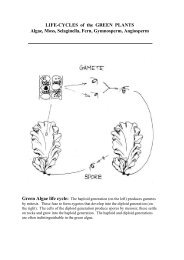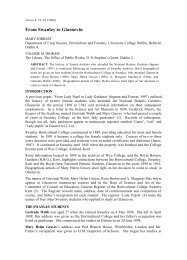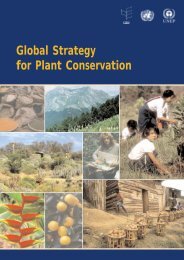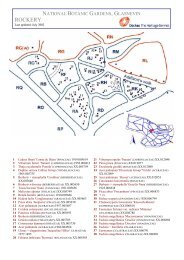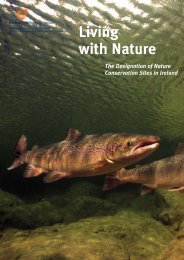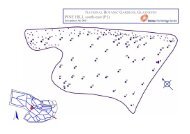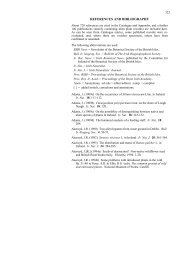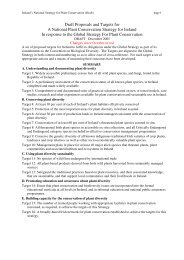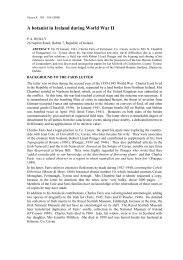ylamino)-1-methyl-1,3,5,triazine-2,4(1H,3H)-dione);simazine (2-chloro-4,6-bis(ethylamino)-s-triazine); <strong>and</strong> terbutrynegranules.(iii) for use as soil residual herbicides, after channel drainage:chlorfenac (dichlobenil(2,6-dichlorobenzonitrile); <strong>and</strong>simazine.Many <strong>of</strong> these herbicides are no longer permitted for usein most aquatic situations (e.g. chlorfenac, hexazinone).Some are <strong>of</strong> doubtful efficacy (e.g. dichlobenil used as a soilresidual herbicide) <strong>and</strong> all are restricted by situation <strong>and</strong>water use. The subject was reviewed by Bowmer et al. (1979)<strong>and</strong> Bowmer (1987).ACKNOWLEDGMENTSWe are grateful to Mike Boulton <strong>and</strong> Laurie Jackel forinformation on the distribution <strong>and</strong> importance <strong>of</strong> <strong>Elodea</strong><strong>canadensis</strong>.LITERATURE CITEDAnderson, L.W.J. <strong>and</strong> N. Dechoretz. 1988. Bensulfuron methyl: A new herbicide.In: Proceedings, 22nd Annual Meeting, Aquatic Plant ControlResearch Program, 16-19 November 1987, Portl<strong>and</strong> Oregon, EnvironmentalLaboratory, US Army Engineers Waterways Experiment Station,Vicksburg, MS pp. 224-235.Anonymous. 1992. Du Pont halts work on Mariner, Aquaphyte, University <strong>of</strong>Florida, Gainesville, p. 2.Aston, H.I. 1973. Aquatic Plants <strong>of</strong> Australia. Melbourne University Press,pp. 216-217.Aston, J.L. <strong>and</strong> J. Reynaert, J. 1974. The current <strong>and</strong> potential use <strong>of</strong> the triazineherbicides in water. Proceedings <strong>of</strong> the EWRS 4th Symposium onAquatic Weeds, pp. 244-252.Bonar, S.A., G.L. Thomas, <strong>and</strong> G.B. Pauley. 1987. Estimation <strong>of</strong> triploidWhite Amur stocking densities for aquatic plant control for Devils Lake,Oregon, Proceedings 21st Annual Meeting Aquatic Plant controlResearch Program, Miscellaneous Paper A-87-2, US Army EngineerWaterways Experiment Station, Vicksburg, Mississippi, pp. 122-132.Bowes, G. <strong>and</strong> M.E. Salvucci. 1989. Plasticity in the photosynthetic carbonmetabolism <strong>of</strong> submersed aquatic macrophytes. Aquat. Bot. 34:233-266.Bowers, K.L., G.B. Pauley, <strong>and</strong> G.L. Thomas. 1987. Feeding preference onPacific Northwest aquatic plant species by diploid <strong>and</strong> triploid GrassCarp (Ctenopharyngodon idella). Proceedings 21st annual Meeting AquaticPlant Control Research Program, Miscellaneous Paper A-87-2, US ArmyEngineer Waterways Experiment Station, Vicksburg, Mississippi, pp. 133-140.Bowmer, K.H. 1982a. Adsorption characteristics <strong>of</strong> seston in irrigation water:implication for the use <strong>of</strong> aquatic herbicides. Aust J Mar Freshwater Res,33:443-458.Bowmer, K.H. 1982b. Aggregates <strong>of</strong> particulate matter <strong>and</strong> aufwuchs on <strong>Elodea</strong><strong>canadensis</strong> in irrigation waters, <strong>and</strong> inactivation <strong>of</strong> diquat. Aust J MarFreshwater Res, 33:589-593.Bowmer, K.H. 1987. Herbicides in surface water. In: Herbicides, D.H. Hutson<strong>and</strong> T.R. Roberts, eds., John Wiley & Sons Ltd, Chichester, pp. 271-355.Bowmer, K.H., D.S. Mitchell, <strong>and</strong> D.L. Short. 1984. <strong>Biology</strong> <strong>of</strong> <strong>Elodea</strong><strong>canadensis</strong> Mich. <strong>and</strong> its management in Australian irrigation systems.Aquat. Bot. 18:231-238.Bowmer, K.H. <strong>and</strong> G.R. Sainty. 1977. <strong>Management</strong> <strong>of</strong> aquatic plants withacrolein. J. Aquat. Plant Manage. 15:40-46.Bowmer, K.H., G.R. Sainty, G. Smith <strong>and</strong> K. Shaw 1979. <strong>Management</strong> <strong>of</strong> <strong>Elodea</strong>in Australian irrigation systems. J. Aquat. Plant Manage. 17:4-12.Bowmer, K.H., K. Shaw <strong>and</strong> J.A. Adeney. 1985. <strong>Management</strong> <strong>of</strong> submergedaquatic macrophytes with terbutryne: availance, phytotoxicity <strong>and</strong> persistence.Weed Res. 25:449-459.Bowmer, K.H. <strong>and</strong> G.H. Smith. 1984. Herbicides for injection into flowingwater: acrolein <strong>and</strong> endothal-amine. Weed Res. 24:201-211.Brown, J.M.A., F.I. Dromgoole, M.W. Towsey, <strong>and</strong> J. Browse. 1974. Photosynthesis<strong>and</strong> photorespiration in aquatic macrophytes. In: Mechanisms <strong>of</strong>Regulation <strong>of</strong> Plant Growth, R.L. Bieliski, A.R. Ferguson, <strong>and</strong> M.M.Cresswell, eds., The Royal Society <strong>of</strong> New Zeal<strong>and</strong>, Wellington, pp. 243-249.Burrows, D. 1993. ASL Newsletter 31(1),58.Cook, C.D.K. 1982. Pollination mechanisms in the Hydrocharitaceae. In:Studies on Aquatic Vascular Plants, J.J Symoen, S.S. Hooper <strong>and</strong> P. Compère,eds., Royal Botanical Society <strong>of</strong> Belgium, Brussels, pp. 1-15.Cook, C.D.K. <strong>and</strong> K. Urmi-König. 1985. A revision <strong>of</strong> the genus <strong>Elodea</strong>(Hydrocharitaceae). Aquat. Bot. 21:111-156.Correll, D.S. <strong>and</strong> H.B Correll. 1975. Aquatic <strong>and</strong> Wetl<strong>and</strong> Plants <strong>of</strong> SouthwesternUnited States, University Press, Stanford, California, pp. 163-167.Fowler, M.C. <strong>and</strong> T.O. Robson. 1978. The effects <strong>of</strong> the food preferences<strong>and</strong> stocking rates <strong>of</strong> grass carp (C. idella) on mixed plant communities.Aquat. Bot. 5:261-276.Godshalk, G.L., J.W. Barko, <strong>and</strong> W.F. James. 1987. Effects <strong>of</strong> submersedaquatic plants on their environment. Proceedings 21st Annual MeetingAquatic Plant Control Research Program, Miscellaneous Paper A-87-2,US Army Engineer Waterways Experiment Station, Vicksburg, Mississippi,pp. 215-224.Haramoto, T. <strong>and</strong> Ikusima, I. 1988. Life cycle <strong>of</strong> Egeria densa Planch., anaquatic plant naturalized in Japan. Aquat. Bot. 30:389-403.Hejny, S. <strong>and</strong> S. Husák. 1978. In: Pond Littoral Ecosystems Structure <strong>and</strong>Functioning, D. Dykyjová <strong>and</strong> J. Kvet, eds. Springer-Verlag, Berlin, pp.36-37.Howard-Williams, C. <strong>and</strong> W.F. Vincent. 1983. Plants <strong>of</strong> the littoral zone. InLake Taupo: ecology <strong>of</strong> a New Zeal<strong>and</strong> lake, D.J. Forsyth <strong>and</strong> C. Howard-Williams, eds., Science Information Publishing Centre, Department <strong>of</strong>Scientific <strong>and</strong> Industrial Research, Wellington, New Zeal<strong>and</strong>. pp.73-84.Hughes, H.R. 1976. Research into aquatic weeds in New Zeal<strong>and</strong> waterways:a review. DSIR Information Series No. 116, N.Z. Department <strong>of</strong> Scientific<strong>and</strong> Industrial Research, 34pp.Keeley, J.E. 1990. Photsynthetic pathways in freshwater aquatic plants.Trends in Ecology <strong>and</strong> Evolution 5:330-333.Kelly, G.J. <strong>and</strong> E. Latzko. 1982. IV. Photosynthesis. Carbon metabolism: thepr<strong>of</strong>ound effects <strong>of</strong> illumination on the metabolism <strong>of</strong> photosyntheticcells. Prog Bot 44:103-131.Maberly, S.C. 1983. The interdependence <strong>of</strong> photon irradiance <strong>and</strong> free carbondioxide or bicarbonate concentration on the photosynthetic compensationpoints <strong>of</strong> freshwater plants. New Phytol. 93:1-12.Maberly, S.C. <strong>and</strong> D.H.N. Spence. 1983. Photosynthetic inorganic carbonuse by freshwater plants. J. Ecol. 77:705-724.Mason, R. 1975. The Macrophytes. In: New Zeal<strong>and</strong> Lakes V.H. Jolly <strong>and</strong>J.M.A. Brown, eds., Auckl<strong>and</strong> University Press; Oxford University Press,pp. 239-240.Mackenzie, D., R. Frank, <strong>and</strong> G.J. Sirons. 1983. Aquatic plant control <strong>and</strong>disappearance <strong>of</strong> terbutryne from treated waters in Ontario, Canada1974-1977. J. Aquat. Plant Manage. 21:11-16.McCorkelle, G., G.R. Sainty <strong>and</strong> K.H. Bowmer. 1992a. Evaluation <strong>of</strong> Sonar(Fluridone) for aquatic plant management in Australia. Final report forDow Elanco Australia Ltd, Consultancy Report No 92/2. CSIRO Division<strong>of</strong> Water Resources, Griffith NSW. 58pp.McCorkelle, G., G.R. Sainty <strong>and</strong> K.H. Bowmer. 1992b. Use <strong>of</strong> Bensulfuron inirrigation supply systems in Australia. Report for Du Pont (Australia)Ltd, Consultancy report No 93/43. CSIRO Division <strong>of</strong> Water Resources,Griffith NSW. 20pp.Mues, R. 1983. Species specific flavone glucoronides in <strong>Elodea</strong> species. BiochemSyst Ecol 11:261-265.Murphy, K.J. 1982. The use <strong>of</strong> methylthiotriazines in fresh-water systems: areview. Proceedings <strong>of</strong> the EWRS 6th Symposium on Aquatic Weeds, pp.263-277.Olsen, C. 1954. Mvilke betingelser ma voere opfyldte for at <strong>Elodea</strong> <strong>canadensis</strong>kan opna den optimale udvikling, der er arsag til dens masseviseoptraeden in naturen? [What are the conditions <strong>of</strong> optimum developmentenabling <strong>Elodea</strong> <strong>canadensis</strong> to grow pr<strong>of</strong>usely in nature?] BotaniskTidsskrift 51: 271-273.Pauley, G.B., G.L. Thomas, S.L. Thiesfeld. S.A. Bonar, <strong>and</strong> K.L. Bowers.1987. An overview <strong>of</strong> the use <strong>of</strong> triploid Grass Carp (Ctenopharyngodonidella) as a biological control <strong>of</strong> aquatic macrophytes in Devils Lake, Oregon,Proceedings 21st Annual Meeting Aquatic Plant Control Research18 J. Aquat. Plant Manage. 33: 1995.
Program, Miscellaneous Paper A-87-2, US Army Engineer WaterwaysExperiment Station, Vicksburg, Mississippi, pp. 115-121.Prins, H.B.A., J.F.H. Snel, <strong>and</strong> P.E. Zanstra. 1982. The mechanism <strong>of</strong> photosyntheticbicarbonate utilization. In: Studies on Aquatic Vascular Plants,J.J. Symoens <strong>and</strong> S.S. Hoor, eds., Royal Botanical Society <strong>of</strong> Belgium, pp.120-126.Rørslett, B., D. Berge, <strong>and</strong> S.W. Johansen. 1985. Mass invasion <strong>of</strong> <strong>Elodea</strong><strong>canadensis</strong> in a mesotrophic, South Norwegian lake - impact on waterquality. Verh. Internat. Verein. Limnol. 22:2920-2926.Sainty, G.R. <strong>and</strong> S.W.L. Jacobs. 1981. Waterplants <strong>of</strong> New South Wales. WaterResources Commission <strong>of</strong> New South Wales. 550pp.Sainty, G.R. <strong>and</strong> S.W.L. Jacobs. 1988. Waterplants in Australia, Sainty & Associates.Sydney, pp. 65-71.Sculthorpe, C.D. 1967. The <strong>Biology</strong> <strong>of</strong> Aquatic Vascular Plants, EdwardArnold, London, 610 pp.Simpson, D.A. 1984. A short history <strong>of</strong> the introduction <strong>and</strong> spread <strong>of</strong> <strong>Elodea</strong>Michx in the British Isles. Watsonia 15:1-9.Taylor, M.E.U. 1971. A study <strong>of</strong> elodea growth in some low-nutrient lakes. In:Symposium on Natural Water Quality <strong>and</strong> Waste Treatment Technology,Massey University, New Zeal<strong>and</strong>, pp. 27-38.US Army Corps <strong>of</strong> Engineers. 1987. Proceedings 21st Annual MeetingAquatic Plant Control Research Program, Miscellaneous Paper A-87-2,US Army Engineer Waterways Experiment Station, Vicksburg, Mississippi,pp. 5-30.Whitfort, L.A. 1982. Investigations into the composition <strong>of</strong> epiphytic communities<strong>and</strong> their influence on the uptake <strong>of</strong> diquat by <strong>Elodea</strong> <strong>canadensis</strong>Rich. MSc. Thesis, University <strong>of</strong> New South Wales; CSIRO Division <strong>of</strong>Irrigation Research, Griffith, New South Wales, 132 pp.J. Aquat. Plant Manage. 33: 19-22Waterbird Abundance <strong>and</strong> Activity onWaterhyacinth <strong>and</strong> Egeriain the St. Marks River, FloridaABSTRACTWaterbird densities <strong>and</strong> activities were quantified on twononnative plant species, waterhyacinth <strong>and</strong> egeria, in a northFlorida coastal plain river. Individual waterhyacinth mats <strong>and</strong>egeria plots were marked in three successive river sections,<strong>and</strong> birds were viewed weekly from 7 July to 20 September1991. Total bird densities <strong>and</strong> counts for individual specieswere similar between plant species on all observation dates(P>0.05). The Little blue heron, Common moorhen, <strong>and</strong> theTricolored heron were the most common species <strong>and</strong> foragingwas the primary activity on both plant species. Birds stalkingin waterhyacinth most <strong>of</strong>ten obtained prey located nearthe perimeter <strong>of</strong> mats, <strong>and</strong> rarely hunted for food in the interior<strong>of</strong> mats.Key words: coastal river, nonnative plant, Little blue heron,Tricolored heron, Common moorhen, bird foraging.INTRODUCTIONBird distributions within water-bodies are <strong>of</strong>ten related toprey densities <strong>and</strong> the ability <strong>of</strong> individual species, through1 Florida Department <strong>of</strong> Environmental Protection, Bureau <strong>of</strong> AquaticPlant <strong>Management</strong>, 3917 Commonwealth Boulevard, Tallahassee, Florida32399, USA. Received for publication March 28, 1994 <strong>and</strong> in revised formJanuary 4, 1995.2 Collopy, M. W. <strong>and</strong> H. L. Jelks. 1989. Distribution <strong>of</strong> foraging wadingbirds in relation to the physical <strong>and</strong> biological characteristics <strong>of</strong> freshwaterwetl<strong>and</strong>s in southwest Florida. Florida Game <strong>and</strong> Fresh Water Fish Comm.Nongame Wildl. Prog. Final Rep. Tallahassee, FL. 102pp.WILLIAM BARTODZIEJ AND G. WEYMOUTH 1specialized adaptations, to efficiently capture prey (Jenni1969, Kushlan 1973, Willard 1977, Kushlan 1978). Aquaticvegetation, which commonly harbors invertebrate <strong>and</strong> vertebrateprey, is generally considered a more favorable foraginghabitat than deep, open-water areas. In terms <strong>of</strong> waterbirdforaging success, certain vegetation communities may providebetter hunting grounds than others (Zaffke 1984) 2 .Little if any data exists on waterbird abundance <strong>and</strong>behavior on river plants found in Florida. The purpose <strong>of</strong>this study was to quantify bird densities <strong>and</strong> record bird activitieson the nonnative egeria (Egeria densa Planchon) <strong>and</strong>waterhyacinth [Eichhornia crassipes (Mart.) Solms].STUDY SITEThe St. Marks River (30° 16'N, 84° 08'W), located in akarst area <strong>of</strong> Wakulla County, Florida, is spring-fed <strong>and</strong> flowsfor approximately 30 km through flat coastal woodl<strong>and</strong>s. In1988, the Florida Legislature passed a moratorium on herbicideapplications to control aquatic vegetation, primarilywaterhyacinth, in this river. That action resulted in ananthropogenically undisturbed, but naturally dynamic plantcommunity in which to observe bird abundance <strong>and</strong> behavior.Since 1988, the waterhyacinth population has exp<strong>and</strong>ed,with frequency-<strong>of</strong>-occurrence estimates varying from 5 to 15percent during the 1989-1992 growing seasons 3 . Althoughwaterhyacinth has the ability to double its biomass (wetweight) in 14 days in unshaded parts <strong>of</strong> the river, weobserved that floods act as a natural control mechanismJ. Aquat. Plant Manage. 33: 1995. 19



